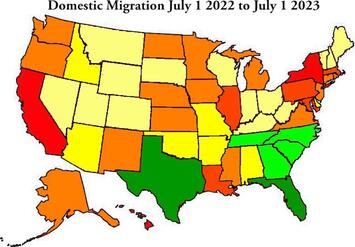
A net 338,000 people who resided in California on July 1, 2022 had left the state by July 1, 2023, according to population estimates released by the Census Bureau last week. This follows a loss of 625,000 residents in the two years prior to July 1 2022, indicating that the pandemic-related forces that led to this migration out of the state are still at work.
International migration plus net birth rates (births minus deaths) meant that California’s overall population declined by only 75,000 people in 2023. This was exceeded by New York, which lost 102,000 people. A net of only about 217,000 New York residents migrated out of the state in 2023, but New York didn’t have as many international immigrants to make up for this loss, so its overall population decline was bigger than California’s.
The overall populations of eight states — New York, California, Illinois, Louisiana, Pennsylvania, Oregon, Hawaii, and West Virginia — declined in the last year. But 23 states plus the District of Columbia saw net domestic out-migrations. These ranged from North Dakota, which lost 9 residents to out-migration, to California at -338,371.
High housing prices are an important reason why people are leaving many of these states. Prices are particularly high in the six states that lost the most residents to domestic migration (CA, IL, MA, MD, NJ, and NY), as well as several more states that lost residents (WA, HI, VA, and OR). But housing prices don’t explain why people are leaving some states. Prices aren’t particularly high in at least six states (IA, KS, MI, MS, NE, or PA) that saw net domestic out-migrations.
Some states gained because they have a combination of moderate housing prices and a beautiful natural environment, which has made them attractive to remote workers. Arizona and Idaho certainly fall into this category, as do Maine, Montana, Utah, and Wyoming. However, Alabama and Oklahoma gained more net residents than Idaho yet few would say they are as scenically attractive. I’d put Louisiana ahead of Oklahoma and rate Alabama and Mississippi about equally, yet Louisiana and Mississippi lost domestic residents while Alabama and Oklahoma gained.
Read the rest of this piece at The Antiplanner.
Randal O'Toole, the Antiplanner, is a policy analyst with nearly 50 years of experience reviewing transportation and land-use plans and the author of The Best-Laid Plans: How Government Planning Harms Your Quality of Life, Your Pocketbook, and Your Future.
Chart: More U.S. residents moved to green and yellow states than left those states, with darker colors representing greater in-migration. More residents moved out of red and orange states than moved to those states, with darker colors representing greater out-migration.













not solid South
Interesting that Louisiana, Mississippi and *Virginia* are outliers to the growth story.